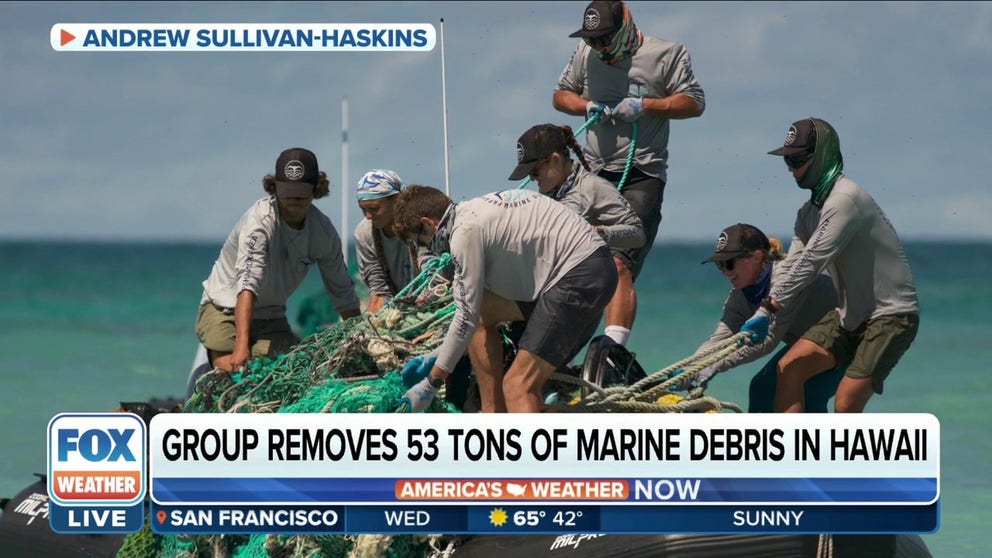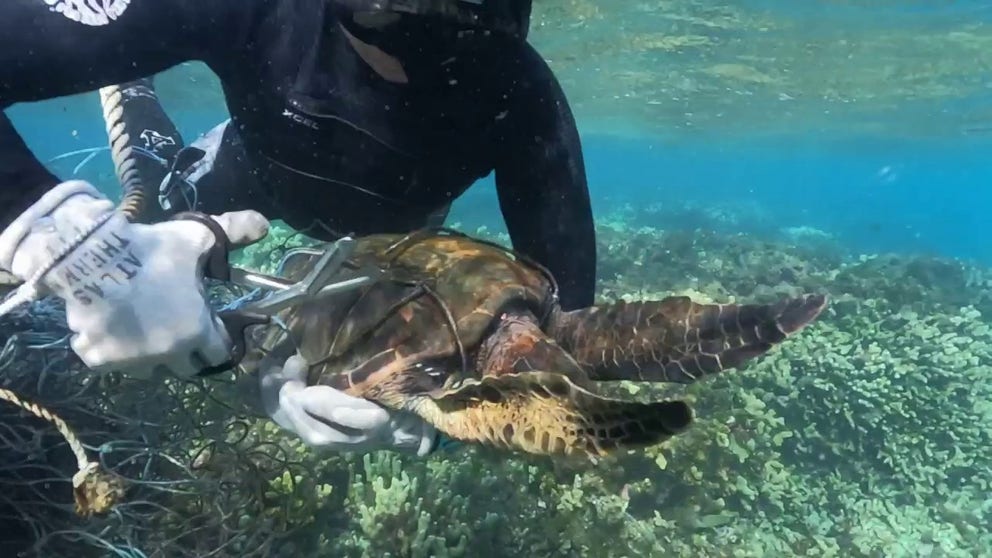Helping Hawaii: Non-profit removes 200,000 pounds of debris from Pacific
A non-profit organizes 2 missions a year to collect tons of marine debris that threatened wildlife eats and can become trapped in.
Hawaii non-profit removes 200,000 pounds of debris from Pacific this year
Papahānaumokuākea Marine Debris Project founder Kevin O’Brien tells FOX Weather how his organization is able to clear massive amounts of ghost nets and plastics from the water that pose threats to marine life.
Marine debris is an accumulating problem for Hawaiian wildlife at 57 tons per year, so one non-profit group is working to give their water and wildlife the best chance for long-term survival.
"Anything from motorcycle helmets to car bumpers to baseball bats and recently a lot of Wilson volleyballs is, believe it or not, due to a container spill that happened near Hawaii," Kevin O’Brien told FOX Weather Monday. "And this time, we actually found a lifeboat that was part of a fire at sea from a large container ship."
O’Brien is the president and co-founder of the Papahanaumokuakea Marine Debris Project (PMDP), a non-profit dedicated to cleaning up the Papahanaumokuakea National Marine Monument. He organized and trained a group of 16 free divers to collect dangerous debris from a 185-foot ship. Animals eat the plastic and get entangled in it.
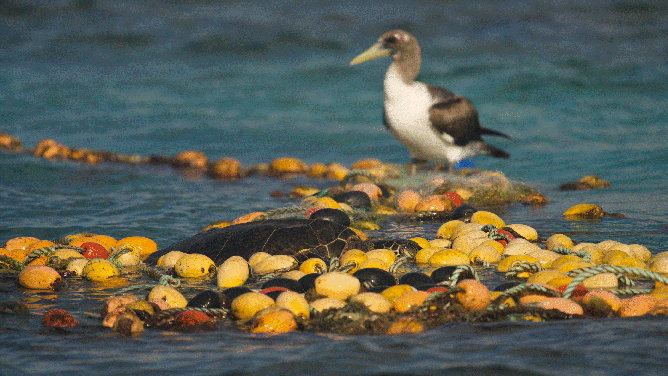
Wildlife like this green sea turtle and masked booby get tangled and eat plastic debris like this net.
(Andrew Sullivan-Haskins / FOX Weather)
The group removed almost a year of junk by hand from the northwestern islands and freed two endangered green sea turtles in just one month.
Fifty-three tons is the equivalent of 10 school buses of derelict fishing nets, ghost nets, and random plastic debris.
DIVERS PULL 25,000 POUNDS OF TRASH FROM LAKE TAHOE
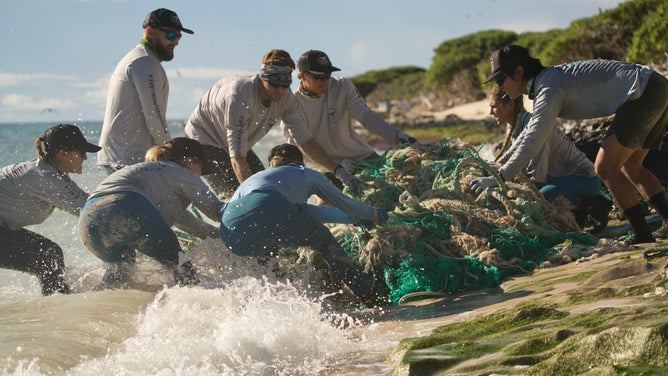
This is just some of the 32,000 pounds of ghost nets that marine debris technicians pulled off the shoreline in just a month.
(Andrew Sullivan-Haskins / FOX Weather)
The remote national monument covers over 1,200 miles from the state's northwest to the main islands. It represents almost 75% of the archipelago.
The area is home to 70% of all coral reefs in the U.S., 3.5 million acres, and over 7,000 species of animals.
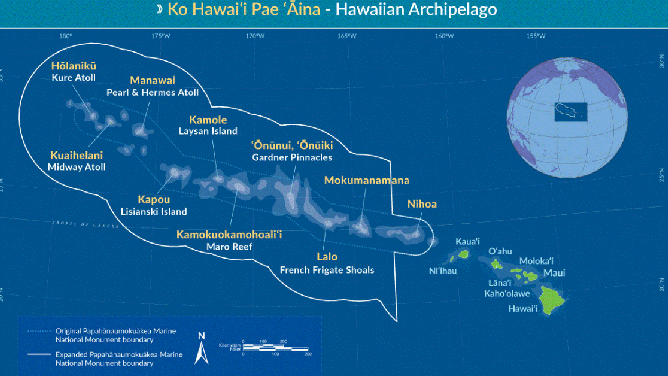
Hawaii is made up of a chain of islands or an archipelago. Papahanaumokuakea is the area west-northwest of the main islands.
(Papahanaumokuakea.gov / FOX Weather)
"It's so remote that when you visit, the animals may have never seen a human," O’Brien said. "And so you'll get birds flying up and just landing on your head."
Ninety percent of all threatened Hawaiian green sea turtles live within the monument.
Unfortunately, O’Brien estimates that for every rescued turtle, 100 others die.
"We stumble upon two Hawaiian green sea turtles that were tangled in a ghost net. We were able to free the animals," he said. "Sharks were circling, so it was only a matter of time before these turtles died."
GENDER REVEAL: SCIENTISTS SAY SAND DETERMINES THE SEX OF SEA TURTLES
Rescuer frees sea turtle from ghost net
A trained, marine debris technician cuts this threatened green sea turtle from a ghost net.
For years, he worked for NOAA, which launched the cleanup project in the 1990s after their research ships noticed a buildup of ghost nets in the area rich with wildlife. Recently the federal funding ran out, so he started the non-profit to keep the cleanup going.
"So you have ocean acidification and coral bleaching and all these kinds of nebulous problems that you can't really do anything about. But marine debris is one thing that we can do something about," said O’Brien. "And so that's the one issue that we can really make a difference, to give the wildlife a better chance of survival because they're dealing with so much."
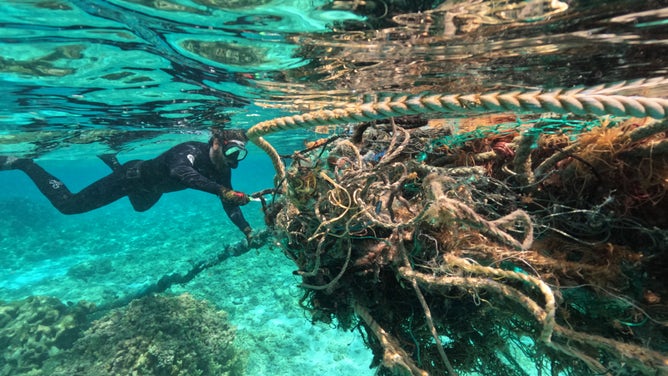
A free-diver cuts a ghost net from a coral reef. Scuba equipment is too cumbersome to use and can also get entangled.
(James Morioka / FOX Weather)
Papahanaumokuakea is an area that sees more marine debris than the main Hawaiian Islands due to ocean currents. Because they are uninhabited, no one is there to clean the trash.
"North of the Hawaiian island chain is this area known as the subtropical convergence zone. And there's a lot going on there. It's cold water, deep water mixing with warm water -- there's a lot of oceanographic stuff going on," O’Brien explained. "It also just accumulates this big band of marine debris to the north of Hawaii. And then seasonally, that band gets pushed south."
WATCH: FLYOVER OF WORLD'S LARGEST VOLCANO AS RUMBLES CONTINUE ON HAWAII'S BIG ISLAND
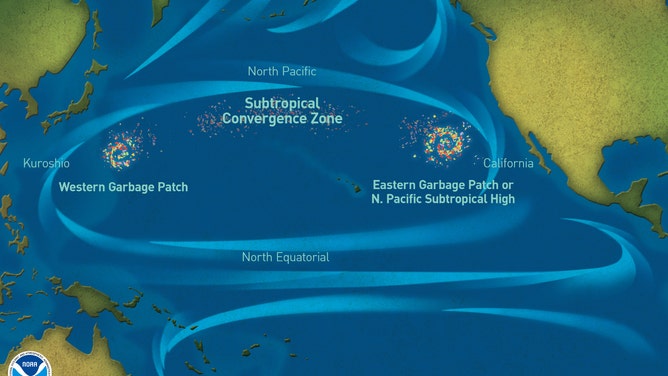
The current in the Pacific flows clockwise around Hawaii. Notice the subtropical convergence zone at the top of the circulation.
(MarineDebris.NOAA.gov / NOAA)
The marine debris is plastic that falls off ships or rides the current from other places.
"The big mystery right now, we're really trying to figure out where a lot of this stuff is coming from," he said. "We do think that a certain amount of it is actually intentionally put into the ocean as a fish aggregation device. And so a lot of fishing boats will do this where they will dump in a little raft or a bundle of net with that, sort of, draping down underneath it which attracts smaller fish which brings in the larger fish."
O’Brien calls them "fish magnets."
Fishermen will attach a satellite tracker to the mass and return to fish there.
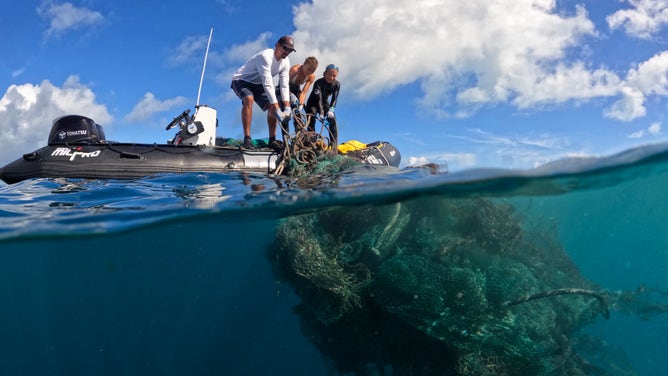
A team hauls ghost nets into their dingy to take back to the ship about 5 miles away.
(James Morioka / FOX Weather)
Right now, PMDP takes the trash back to Oahu. A local steel company agreed to chop up the trash and transport it to the power plant for incineration and energy generation.
"A good place to start by keeping it out of landfills," he said.
PMDP just signed on with the Department of Transportation for a pilot program next year.
"They're going to start experimenting with using recycled fishing nets as part of the asphalt mix when they do new roads," he said. "To see if they can get away from using the virgin plastics or fibers that they normally put in the asphalt and use this fishing net material that we don't know what to do with."
HOW TO WATCH FOX WEATHER ON TV
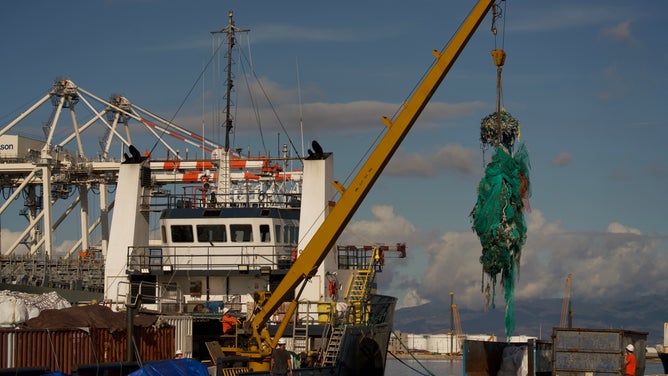
The PMDP team off loads the tons of debris in Honolulu.
(Andrew Sullivan-Haskins / FOX Weather)
This is the second year of a 5-year project that O’Brien hopes will eliminate a million-ton backlog of debris on the beaches and in the water. He said it is hard to generate funding for such a remote area that most people have never seen.
"We just try to show people this really amazing place. And then, ‘Hey, also look at this problem that it suffers from. But guess what? There's a solution,'" he said, understanding the world’s fatigue dealing with gloom and doom environmental issues. "Just showing the place to people is really important because you protect what you love. And if you don't know about it, you can't love something."
PMDP’s next missions will be in the summer and fall of 2023.
Over the past two years, the group collected a half-million pounds of nets and plastic debris.
